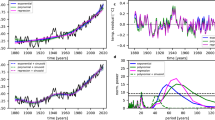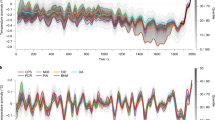Abstract
Analysis of observational temperature records for the Northern and Southern hemispheres indicates a statistical relationship in which Northern Hemisphere temperature depends on temperature in the Southern Hemisphere. This pattern, which has strengthened over time, can be explained by the climatic effects of anthropogenic trace gases and tropospheric sulphate aerosols. A similar statistical patternis produced by model simulations of the historical atmosphere.
This is a preview of subscription content, access via your institution
Access options
Subscribe to this journal
Receive 51 print issues and online access
$199.00 per year
only $3.90 per issue
Buy this article
- Purchase on Springer Link
- Instant access to full article PDF
Prices may be subject to local taxes which are calculated during checkout

Similar content being viewed by others
References
Jones, P. D. Hemispheric surface air temperature variations: a reanalysis and an update to 1993. J. Clim. 7, 1794– 1802 (1994).
Vinnikov, K. Y., Groisman, P. Y. & Lugina, K. M. Empirical data on contemporary global climate changes (temperature and precipitation). J. Clim. 3, 662–677 (1990).
Hansen, J. & Lebedeff, S. Global trends of measured air temperature. J. Geophys. Res. 92, 13345– 13372 (1987).
Kerr, R. A. Is the world warming or not. Science 267, 612 (1995).
Schneider, S. H. Detecting climatic change signals: are there any fingerprints? Science 263, 341–347 ( 1994).
Lindzen, R. S. Some coolness concerning global warming. Bull. Am. Meteorol. Soc. 71, 288–299 ( 1990).
Santer, B. D., Wigley, T. M. L., Barnett, T. P. & Anyamba, E. in Climate Change 1995: The Science of Climate Change(eds Houghton, J. T. et al.) 407–433 (Cambridge Univ. Press, (1996)).
Santer, B. D. et al. Asearch for human influences on the thermal structure of the atmosphere. Nature 382, 39– 46 (1996).
Lane, L. J., Nichols, M. H. & Osborn, H. B. Time series analysis of global change data. Environ. Pollut. 83, 63–88 (1994).
Kuo, C., Lindberg, C. & Thomson, D. J. Coherence established between atmospheric carbon dioxide and global temperature. Nature 343, 709–714 (1990).
Thomson, D. J. The seasons, global temperature, and precision. Science 268, 59–68 (1995).
Schönwiese, C. D. Analysis and prediction of global climate temperature change based on multiforced observational statistics. Environ. Pollut. 83, 149–154 (1994).
Tol, R. S. J. & de Vos, A. F. Greenhouse statistics–time series analysis. Theor. Appl. Climatol. 48, 63–74 (1993).
Tol, R. S. J. Greenhouse statistics–time series analysis: Part II. Theor. Appl. Climatol. 49, 91–102 (1994).
Lean, J. L., Beer, J. & Bradley, R. Reconstruction of solar irradiance since 1610: implications for climate change. Geophys. Res. Lett. 22, 3195–3198 (1995).
Granger, C. W. J. Investigating causal relations by econometric models and cross spectral models. Econometrica 37, 424–438 (1969).
Sims, C. Macroeconomics and reality. Econometrica 48, 1–49 (1980).
Nicholls, N. et al. in Climate Change 1995: The Science of Climate Change(eds Houghton, J. T. et al.) 138–192 (Cambridge Univ. Press, (1996)).
Parker, D. E., Jones, P. D., Folland, C. K. & Bevan, A. 1994. Interdecadal changes of surface temperatures since the late 19th century. J. Geophys. Res. 99, 14373– 14399 (1994).
Dickey, D. A. & Fuller, W. A. Distribution of the estimators for autoregressive time series with a unit root. J. Am. Statist. Assoc. 74, 427–431 ( 1979).
Phillips, P. & Perron, P. Testing for a unit root in time series regression. Biometrica 75, 335– 346 (1988).
Akaike, H. in 2nd Int. Symp. on Information Theory(eds Petrov, P. N. & Csaki, F.) 267–281 (Akadacemiai Kiadaco, Budapest, (1973)).
Hamilton, J. D. Time Series Analysis(Princeton Univ. Press, (1994)).
Schmidt, P. & Phillips, P. C. B. LM tests for a unit root in the presence of deterministic trends. Oxford Bull. Econ. Statist. 34, 357–287 ( 1992).
Johansen, S. Statistical analysis of cointegration vectors. J. Econ. Dynam. Control 12, 231–254 ( 1988).
Johansen, S. & Juselius, K. Maximum likelihood estimation and inference on cointegration with application to the demand for money. Oxford Bull. Econ. Statist. 52, 169– 209 (1990).
Enders, W. Applied Econometric Time Series(Wiley, New York, (1995 )).
Toda, H. Y. & Phillips, P. C. B. The spurious effects of unit roots on exogeneity tests in vector autoregressions: an analytic study. J. Econometr. 59, 229–255 (1993).
Ohanian, L. E. The spurious effects of unit roots on vector autoregressions. J. Econometr. 39, 251–266 (1988).
Philander, S. G. El Nino, La Nina, and the Southern Oscillation(Academic, San Diego, (1990)).
Alkezweeny, A. J. Trend analyses of sulfur dioxide emissions and sulfate concentrations and their application for global cooling. Atmósfera 8, 91–97 (1995).
Kiehl, J. T. & Briegleb, B. P. The relative roles of sulphate aerosols and greenhouse gases in climate forcing. Science 260, 311–314 (1993).
Keeling, C. D. et al. in Aspects of Climate Variability in the Pacific and Western Americas(ed. Petersen, D. H.) 165–236 (Geophys. Monogr. 55, Am. Geophys. Un., Washington DC, (1989)).
Siegenthaler, U. & Sarmiento, J. L. Atmospheric carbon dioxide and the ocean. Nature 365, 119–125 (1993).
Faser, P. & Derek, N. in Baseline 91(eds Dick, C. & Gras, J.) 70–81 (Bureau of Meteorology-CSIRO, Melbourne, (1994)).
Fraser, P., Penkett, S., Gunson, M., Weiss, R. & Rowland, F. S. in Concentrations, Lifetimes, and Trends of CFC's Halons, and Related Species(eds Kay, J, Penket, S. & Ormand, F.) 1.1–1.68 (Rep. No. 1339, NASA, Washington DC, (1994)).
Engle, R. E. & Granger, C. W. J. Cointegration and error-correction: representation, estimation, and testing. Econometrica 55, 251–276 (1987).
Mitchell, J. F. B., Johns, T. C., Gregory, J. M. & Tett, S. F. B. Climate response to increasing levels of greenhouse gases and sulphate aerosols. Nature 376, 501–504 (1995).
Christiano, L. J. Searching for a break in GNP. J. Bus. Econ. Statist. 10, 237–250 (1992).
Prather, M., McElroy, M., Wofsy, S., Russel, G. & Rind, D. Chemistry of the global troposphere: fluorocarbons as tracers of air motion. J. Geophys. Res. 92, 6579–6613 (1987).
Elkins, J. W. et al. in Trends 93: A Compendium of Data on Global Change(eds Boden, T. A., Kaiser, D. P., Sepanski, R. J. & Stoss, F. S.) 501 –504 (ORNL/CDIAC-65, Carbon Dioxide Information Analysis Center, Oak Ridge Natl Lab., Oak Ridge, TN, (1994)).
Etheridge, D. M., Pearman, G. I. & Fraser, P. J. in Trends '93: A Compendium of Data on Global Change (eds Boden, T. A., Kaiser, D. P., Sepanski, R. J. & Stoss, F. S.) 256–260 (ORNL/CDIAC-65, Carbon Dioxide Information Analysis Center, Oak Ridge Natl Lab., Oak Ridge, TN, (1994 )).
Khalil, M. A. K. & Rasmussen, R. A. Global emissions of methane during the last several centuries. Chemosphere 29, 833–842 (1994).
Dlugokenchy, E. J., Lang, P. M., Masarie, K. A. & Steele, L. P. in Trends '93: A Compendium of Data on Global Change(ORNL/CDIAC-65, Carbon Dioxide Information Analysis Center, Oak Ridge Natl Lab., Oak Ridge, TN, (1994)).
Prinn, R. G. et al. CDIAC World Data Center Dataset No. DB-1001(Available by anonymous ftp from cdiac.esd@ornl.gov).
Etheridge, D. M. et al. Natural and anthropogenic changes in atmospheric CO2 over the last 1,000 years from air in Antarctic ice and firn. J. Geophys. Res. 101, 4115–4128 (1996).
Keeling, C. D. & Whorf, T. P. in Trends '93: A Compendium of Data on Global Change(eds Boden, T. A., Kaiser, D. P., Sepanski, R. J. & Stoss, F. S.) 16–26 (ORNL/CDIAC-65, Carbon Dioxide Information Analysis Center, Oak Ridge Natl Lab., Oak Ridge, TN, (1994)).
Prinn, R. D. et al. Atmospheric emissions and trends of nitrous oxide deduced from ten years of ALE/GAGE data. J. Geophys. Res. 95 , 18369–18385 (1990).
Prinn, R. D. et al. CDIAC World Data Center Dataset No. DB-1001(Oak Ridge, (1995)).
Machida, T., Nakazawa, T., Fujii, Y., Aooki, A. & Watanabe, O. Increase in the atmospheric nitrous oxide concentration during the last 250 years. Geophys. Res. Lett. 22, 2921–2924 ((1995)).
Stern, D. I. & Kaufmann, R. K. Estimates of Global Anthropogenic Sulfate Emissions 1860–1993(Working Paper 9602, Centre for Energy & Environmental Studiies, Boston University, (1996)); (available at http://cres.anu.edu.au/∼dstern/CEES_WP/9602.w)
Sato, M., Hansen, J. E., McCormick, D. J. & Pollack, J. B. Stratospheric aerosol optical depths, 1850–1990. J. Geophys. Res. 98, 22987–2294 ( 1993).
Shine, K. P. R. G., Derwent, D. J., Wuebbles, D. J. & Mocrette, J. J. in Climate Change: The IPCC Scientific Assessment(eds Houghton, J. T., Jenkins, G. J. & Ephramus, J. J.) 47–68 (Cambridge Univ. Press, (1991)).
Kattenberg, A. F. et al. in Climate Change 1995: The Science of Climate Change(eds Houghton, J. T. et al.) 289–357 (Cambridge Univ. Press, (1996)).
Acknowledgements
We thank the following individuals for data: T. Boden, L. D. Harvey, J. Lean, M. Sato and D. Viner. We thank B. P. Briegleb, M. Friedl, S. Hall, G. Hegerl, J. Key, P. Mayewski, B. Moore III, G. Salvucci, H. Y. Toda, K. Trenberth and P. Young for comments on preliminary versions of this Article.
Author information
Authors and Affiliations
Corresponding author
Rights and permissions
About this article
Cite this article
Kaufmann, R., Stern, D. Evidence for human influence on climate from hemispheric temperature relations. Nature 388, 39–44 (1997). https://doi.org/10.1038/40332
Received:
Accepted:
Issue Date:
DOI: https://doi.org/10.1038/40332
This article is cited by
-
Anthropogenic influence on extremes and risk hotspots
Scientific Reports (2023)
-
An empirical estimate for the snow albedo feedback effect
Climatic Change (2023)
-
Contribution of Solar Irradiance Variations to Surface Air Temperature Trends at Different Latitudes Estimated from Long-term Data
Pure and Applied Geophysics (2023)
-
Could detection and attribution of climate change trends be spurious regression?
Climate Dynamics (2022)
-
Feedbacks among electric vehicle adoption, charging, and the cost and installation of rooftop solar photovoltaics
Nature Energy (2021)
Comments
By submitting a comment you agree to abide by our Terms and Community Guidelines. If you find something abusive or that does not comply with our terms or guidelines please flag it as inappropriate.



